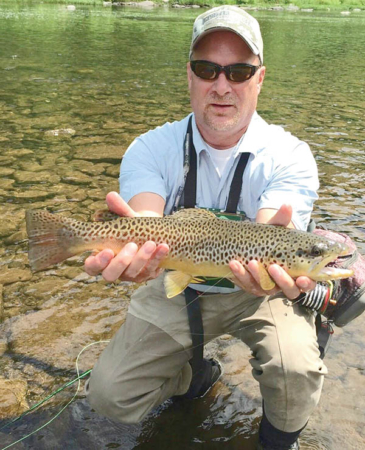Like most outdoorsmen right now, I, too, am spending as much time as I can trying to tag a deer. After one nine-hour day sitting in a treestand and another half day in my stand in the rain, I still have all my deer tags. While I’m caught up in the hunting scene right now, I also know that fall is a good time to hit the trout stream, and I may do that before the snow flies. In the meantime, a fishing buddy of mine, Doug Zehner, has had some productive outings on several trout streams already this fall.
I ran into Doug recently, and I didn’t hesitate to pick his brain. Doug is a top-notch fly fisherman, and he is also an outstanding at tying flies.
Doug was quick to point out that one good reason to hit the stream in the fall is that very few people have, and truthfully by mid-summer, most fishermen have stopped chasing trout and moved on to other species of fish. The cooler fall water temperatures are also a plus and a welcome relief from the warm summer water temperatures. Fishing trout streams this fall may be especially productive, too, since significant rains have kept streams at good levels all summer and now into the fall.
As we move into fall and water temperatures continue to drop, a trout’s metabolism also slows, and feeding activity may slow also, but that doesn’t mean you can’t catch trout. Doug considers a half-dozen to a dozen trout caught on any given fall day a good day on the stream; heavens, there are probably a lot of guys thinking that’s a good day in the spring fishing over freshly stocked trout.
Like Doug, when it comes to trout fishing, I much prefer fly fishing, and knowing of his successful fall trout fishing, I was quick to ask him what fly patterns are his most productive.
Come fall, it’s not likely that your typical dry fly patterns will be of much use since trout are probably doing most of their feeding below the surface; thus, nymphs and streamer patterns are better choices.
Some of Doug’s favorite subsurface presentations are egg patterns, Glo Bugs, Pheasant Tail nymphs, and small bead-head nymphs, just to name a few. An assortment of streamers would be wise to have on hand since they imitate minnows, and trout have been chasing them all summer. I also like to have an assortment of Wooly-Buggers in different patterns and some with bead heads.
Doug also felt that it is important to try to put your fly presentation right in front of the trout’s face to improve your chances for a strike since they are not likely to want to exert a lot of energy chasing after food. A good presentation is the popular “high-sticking” method; you keep your rod tip high and often with your arm extended, thus eliminating any slack line on the water. This presentation makes it possible to feel everything that’s happening to your nymph as it rolls along near the bottom.
Doug likes to concentrate his fall fly fishing in tailwaters and deeper pockets, but he will also hit riffles. He also told me he thought the trout in the fall were more tolerant of water in open sunlight, whereas in the summer, they tended to avoid the sun and opt for shaded areas of the stream. You might also want to be careful not to disturb any trout spawning beds; browns and brooks spawn during the fall months.





Leave a Comment
Your email address will not be published. Required fields are marked with *